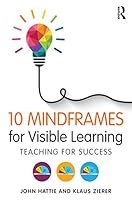# 10 Mindframes for Visible Learning

## Metadata
- Author: [[John Hattie, Klaus Zierer]]
- Full Title: 10 Mindframes for Visible Learning
- Category: #books
## Highlights
- Good work is characterized by 3 Es. It consists in a combination and synthesis of excellence, engagement, and ethics. A successful worker knows what she is doing, sees to it that she gets it done, and can name reasons for why she is doing what she is doing. ([Location 318](https://readwise.io/to_kindle?action=open&asin=B0785MT8DH&location=318))
- Tags: [[pink]]
- Good work is characterized by 3 Es. It consists in a combination and synthesis of excellence, engagement, and ethics. A successful worker knows what she is doing, sees to it that she gets it done, and can name reasons for why she is doing what she is doing. ([Location 318](https://readwise.io/to_kindle?action=open&asin=B0785MT8DH&location=318))
- Tags: [[orange]]
- How does a lawyer deal with a case that seems hopeless? What options are open to a journalist whose inquiries lead to seemingly contradictory facts? What does a scientist do when she reaches a dead end with her research? What successful people do in such cases is enter into a dialogue and try to solve their problems by cooperating with others. ([Location 887](https://readwise.io/to_kindle?action=open&asin=B0785MT8DH&location=887))
- Tags: [[pink]]
- The Rational Optimist (2010). He presents numerous examples of the possibilities and opportunities associated with collective intelligence, including those described in the vignette at the start of this chapter. Ultimately, he even sees collective intelligence as the key feature of successful cultures, institutions, and people, because all less successful cultures, institutions, and people are not open, do not exchange ideas and goods, and therefore do not work together in this regard. Isolation means stagnation and leads in the long term even to regression. ([Location 989](https://readwise.io/to_kindle?action=open&asin=B0785MT8DH&location=989))
- Tags: [[pink]]
- Growth mindset was developed by Carol Dweck from a lifetime of careful and precise research work. She claimed that growth mindsets can inspire different goals and shape views about effort, but she has never claimed in her academic writings that there is a state of mind called “growth mindset” – it is not an attribute of a person, rather, it is a way of thinking in a particular circumstance. She has undertaken many research studies to understand when and where it can be invoked to lead to better outcomes. It is a more a coping strategy than a state of being. ([Location 1191](https://readwise.io/to_kindle?action=open&asin=B0785MT8DH&location=1191))
- Tags: [[orange]]
- In many contexts, it is ultimately the golden mean or the right measure that decides over success or failure – a notion that goes all the way back to Aristotle (Moral behavior is between two extremes – at one end is excess, at the other is deficiency. Find a moderate position between those two extremes, and you will be acting morally.). ([Location 1620](https://readwise.io/to_kindle?action=open&asin=B0785MT8DH&location=1620))
- Tags: [[pink]]
- The factor “Piagetian programs” achieves an effect size of d = 1.28, one of the highest effects in Visible Learning (see Figure 10.1). Among the many contributions made by Jean Piaget is the idea that children change in the ways they think and process as they grow. Their thinking develops qualitatively through successive stages under the influence of maturation and of the social and physical environment. ([Location 2799](https://readwise.io/to_kindle?action=open&asin=B0785MT8DH&location=2799))